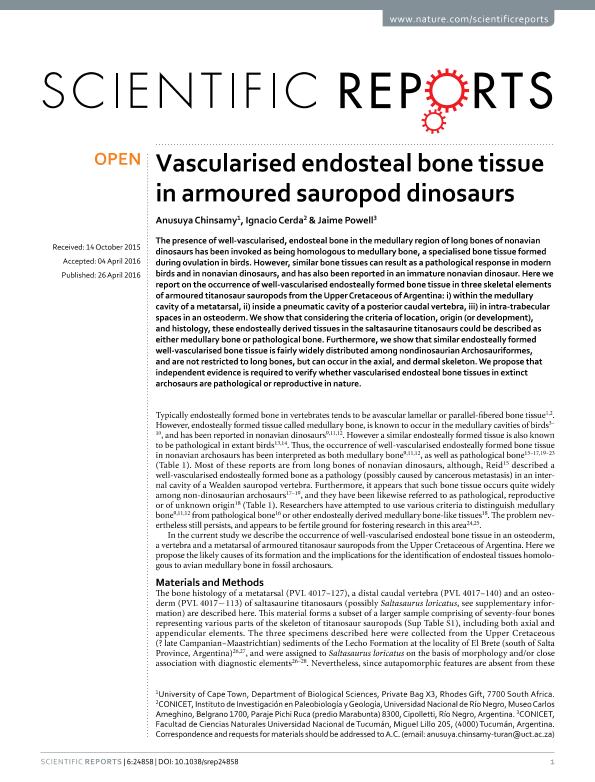Artículo
Vascularised endosteal bone tissue in armoured sauropod dinosaurs
Fecha de publicación:
26/04/2016
Editorial:
Nature Publishing Group
Revista:
Scientific Reports
ISSN:
2045-2322
Idioma:
Inglés
Tipo de recurso:
Artículo publicado
Clasificación temática:
Resumen
The presence of well-vascularised, endosteal bone in the medullary region of long bones of nonavian dinosaurs has been invoked as being homologous to medullary bone, a specialised bone tissue formed during ovulation in birds. However, similar bone tissues can result as a pathological response in modern birds and in nonavian dinosaurs, and has also been reported in an immature nonavian dinosaur. Here we report on the occurrence of well-vascularised endosteally formed bone tissue in three skeletal elements of armoured titanosaur sauropods from the Upper Cretaceous of Argentina: i) within the medullary cavity of a metatarsal, ii) inside a pneumatic cavity of a posterior caudal vertebra, iii) in intra-trabecular spaces in an osteoderm. We show that considering the criteria of location, origin (or development), and histology, these endosteally derived tissues in the saltasaurine titanosaurs could be described as either medullary bone or pathological bone. Furthermore, we show that similar endosteally formed well-vascularised bone tissue is fairly widely distributed among nondinosaurian Archosauriformes, and are not restricted to long bones, but can occur in the axial, and dermal skeleton. We propose that independent evidence is required to verify whether vascularised endosteal bone tissues in extinct archosaurs are pathological or reproductive in nature.
Palabras clave:
Paleohistology
,
Dinosauria
,
Pathology
,
Medullary Bone
Archivos asociados
Licencia
Identificadores
Colecciones
Articulos(CCT - PATAGONIA NORTE)
Articulos de CTRO.CIENTIFICO TECNOL.CONICET - PATAGONIA NORTE
Articulos de CTRO.CIENTIFICO TECNOL.CONICET - PATAGONIA NORTE
Citación
Chinsamy, Anusuya; Cerda, Ignacio Alejandro; Powell, Jaime Eduardo; Vascularised endosteal bone tissue in armoured sauropod dinosaurs; Nature Publishing Group; Scientific Reports; 6; 24858; 26-4-2016; 1-22
Compartir
Altmétricas




